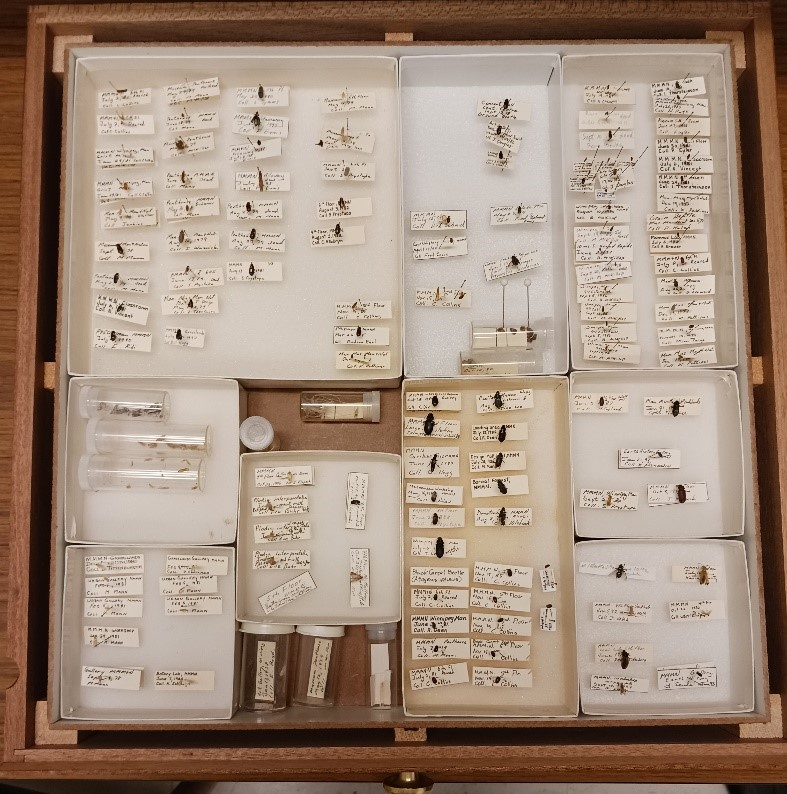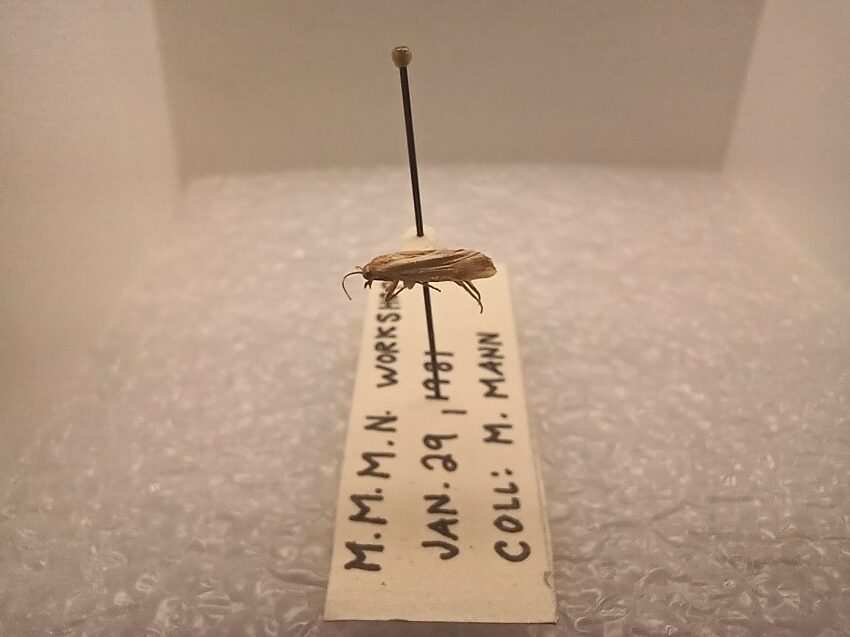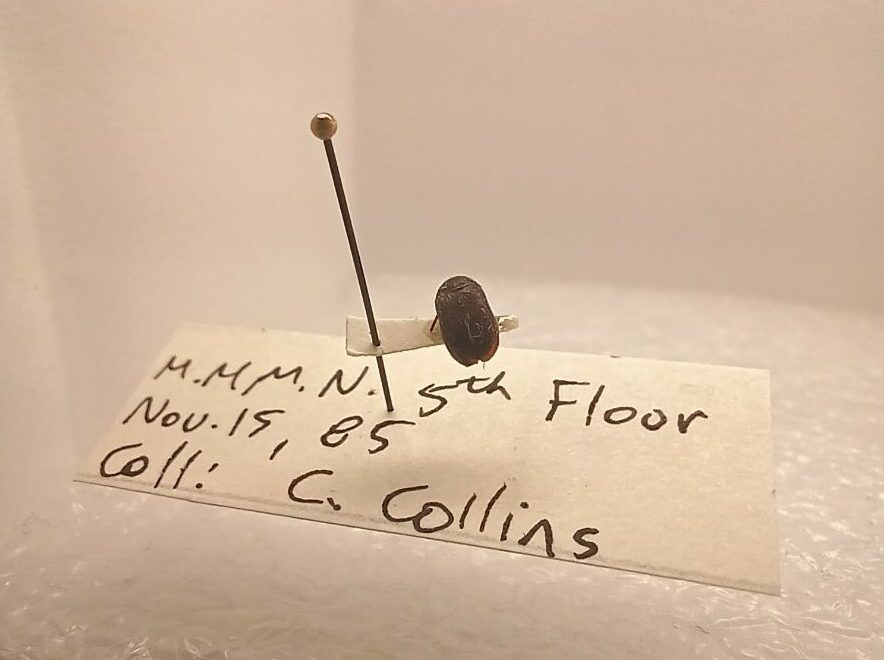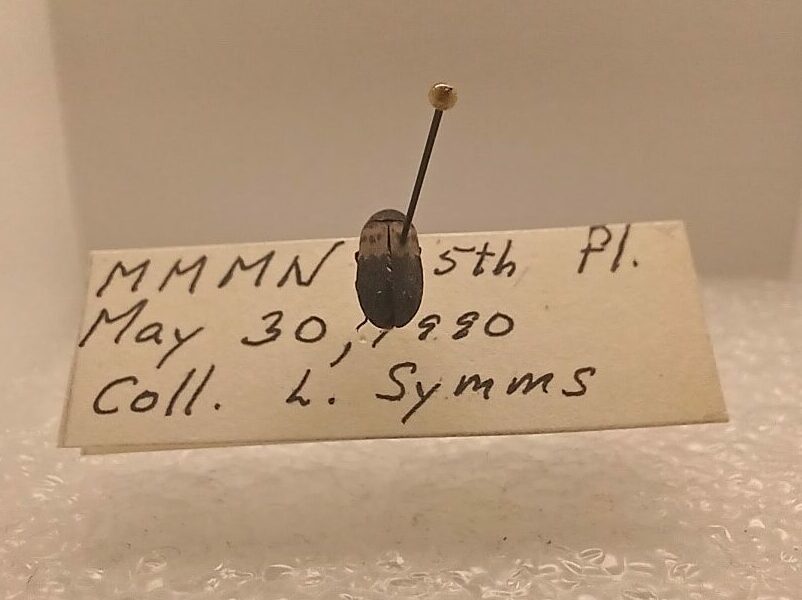
My first day at the Manitoba Museum began with a guided behind-the-scenes tour through the research labs, workshops, and collections storage rooms that are not accessible to the public. On a tight schedule, I got to see a little bit of everything, but when the tour was over I knew I needed to see so much more. Through the next week I found the time to explore the specimens of the Natural History collections room, starting with my favourite group of animals – the insects! The Museum’s insect collection contains fascinating specimens from Manitoba and beyond, sorted neatly by species into glass-topped wooden drawers which are stored in tall, sealed cabinets. In the course of my thorough investigation, I found amazing wasps, rugged beetles, and showstopping butterflies. Nothing, however, captured my imagination quite like the contents of one otherwise unassuming box simply marked “Museum Pests”.
As the label suggested, inside I found a collection of insects that are known to be destructive to museum collections. Capable of eating textiles, paper products, dried plants, and furs, these little insects can be a huge problem if allowed to reproduce in the museum. The specimens were old, their data labels yellowed with age, collected between the ‘70s and the ‘90s by watchful staff right here in the Manitoba Museum.
On an ecological note, it is important to bear in mind that there is nothing inherently “bad” about the organisms we have labeled here as pests. In nature, these insects act as nutrient recyclers and food for many other animals. It is only when their behaviour impacts the livelihood and resources of humans that an animal becomes a “pest”. In this situation, we are simply at odds – our job is to acquire and protect a vast collection of objects with historical and scientific value (or, as the pests would call it, “a huge pile of food with nutritional value”), and their job is to eat well and survive long enough to reproduce.
All that being said, it is my pleasure to introduce you to the insatiable insects of the Manitoba Museum’s Rogues’ Gallery.
Clothes Moth – Tineola bisselliella

The clothes moth is a small, drab moth that packs a punch. In nature, these moths lay their eggs in the nests and carcasses of mammals and birds, providing their caterpillars with easy access to a feast of fur, flesh, and dead insects. In their capacity as pests, they enter buildings and lay their eggs in the presence of animal-derived textiles, specifically those made of wool, silk, and leather. This behaviour ensures that their young have plenty to eat. Walking through the galleries, you may be able to picture the damage that they could do to the historical garments, animal furs, and insect specimens that are on display for the public along, with our stored collections.
Interestingly, the adults of this species do not eat at all, so all of the energy they need to disperse and reproduce comes from food eaten by the caterpillar. The adults of the clothes moth tend to crawl rather than fly. This slow and low movement, combined with their understated colour palette and small size, makes them exceptionally sneaky They can avoid detection by humans with ease, making vigilance and pest control measures a must.
Black Carpet Beetle – Attagenus unicolor

These beetles are tiny – so small, in fact, that the specimens here are pointed rather than pinned directly. As with the clothes moth, the adults disperse to lay eggs near food sources and the larvae that emerge from the eggs do most of the damage. The tiny larvae of these beetles mostly eat natural fibres like wool and silk, making them a threat to clothing, carpets, and rugs stored and on display in the museum. They additionally can eat feathers, fur, and other animal bits, so it is essential that they be kept away from natural history specimens in the galleries and collections. Larvae of these beetles are able to slow their growth when food resources are scarce. Development to the adult life stage can take anywhere from three months to three years! This makes them very difficult to eradicate completely, and even if an infestation appears to be over resurgence is always a possibility.
The Larder Beetle – Dermestes lardarius

The larder beetle (a member of the Dermestid beetle family) may be a familiar insect to some Manitobans. They occasionally wander into kitchens and pantries in search of food, have a distinctive band of yellow hairs crossing their otherwise black bodies, and are generally large enough to be spotted when they move. While they tend to crawl in small, dark spaces, they can also disperse across larger distances by flying. As with the clothes moth, larder beetles are nutrient recyclers in nature, eating plants and animals in various states of decay and returning their nutrients to the soil. If they get into your home, they survive on stored foods such as grains and dried meats, and under the right circumstances major infestations can develop. In a museum, these beetles are able to cause downright havoc
They eat wool, leather, silk, dried plant materials including seeds and grains, animal furs and skins, preserved insects, and even paper. The larvae of this species are particularly hazardous to our collections, as their small size combined with their capacity to climb walls allows them to get to any food that they detect. As if all that wasn’t enough, the larvae are able to bore through solid materials such as wood and plastic. In some cases, they have even been known to bore into tin cans to get at the preserved foods inside!
Pest Control Measures

Due to the damage that they can cause, keeping pests away from the collections of The Manitoba Museum is a matter of utmost importance as we strive to protect the scientific and historical value of the all that is within our care. However, we cannot simply decide that insects will stay out of our museum, as they can fly in through a window, walk through the front door, or even hitch a ride on the clothing of unsuspecting guests. Once they are inside the museum, our pest control measures are the first line of defense.
As a basic measure, food items cannot be brought into certain areas of the museum. In the galleries, many displayed objects and specimens are behind glass cases to physically prevent insect access. Baited sticky traps in use throughout the museum are an excellent way to catch insects when they are present, and monitoring them closely allows us to detect problems before they get out of hand. When new items are acquired by the museum, they are frozen twice or exposed to carbon dioxide to get rid of any insects that may be hitching a ride, even as eggs or larvae. Items held in our collections storage rooms are kept in sealed metal cabinets that can keep out even the smallest of insects. Finally, and perhaps most importantly, protection from pests relies on the vigilance of our team. Museum staff monitor items on display and in the collections for signs of insect activity such as feeding damage, shed skins, frass (for the uninitiated, that’s a technical term for sawdust from bore-holes and insect poop), as well as live insects.
Productive Pest

With all that being said, you might think that we strive to keep our museum completely insect free; however, this is not quite true. Hidden away deep in the museum and behind three locked doors there lies a small, sealed room that a lovely brood of six-legged museum volunteers call home. While cleaning the bones of smaller natural history specimens is a painstaking and time-consuming task for a human, our family of Dermestid beetles is always ready for a meal. Paid only in food, the beetles get our bones thoroughly cleaned and ready for final preparation. Next time you visit the museum, be sure to remember the roles that pests play as friends and foes in the museum as we strive to keep our collections in excellent condition for the research and enjoyment of generations to come. And please, don’t bring any food or drinks into the galleries; protection of the collections also depends on you!
Further Reading:
For more in-depth information on our bone-cleaning Dermestid beetles, check out Janis Klapecki’s blog post, Ladies and Gentlemen…The Beetles
Other resources:
https://extension.umd.edu/resource/clothes-moths
https://museumpests.net/wp-content/uploads/2019/03/Larder-Beetle.pdf
https://extension.psu.edu/larder-beetle
https://entnemdept.ufl.edu/creatures/fabric/black_carpet_beetle.htm



